Doors closing
This week: Some Gully’s wanted; Inside clean-up; Halfway house; A tacky surface; A beneficent weed, or is it?; Just for fun; Giving some latitude; Looking back;

The nights are drawing in quickly now, as we pass the northern Autumnal Equinox. I’ve begun drawing the curtain in my study when I am working in the evening this week.
This is the first time since April. However it’s just for privacy as I work at my desk by the window which overlooks the lane.
Closing the curtains to keep the warmth in, will come later in the year… Lights which are on behind curtained windows in houses are a reminder that winter is almost upon us.
I’ve been out several times around sunset, but on Tuesday I waited for the full moon to rise over Vrbanj.
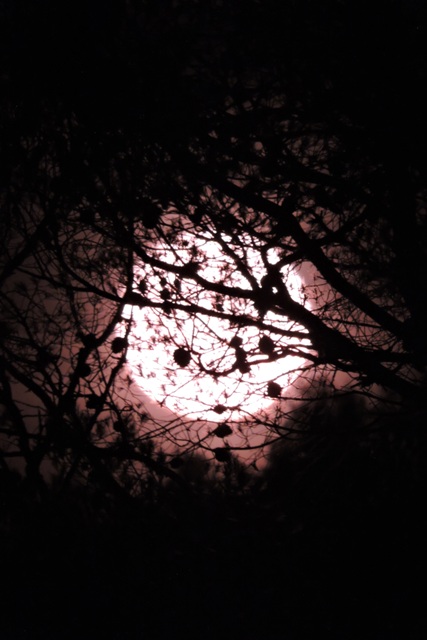
This is called the “Harvest Moon”, because it is the full moon that is closest to the northern autumnal equinox.
One piece of good news is that the Cherry tree which lost all its leaves at the start of August, now has grown a lot of new leaves.
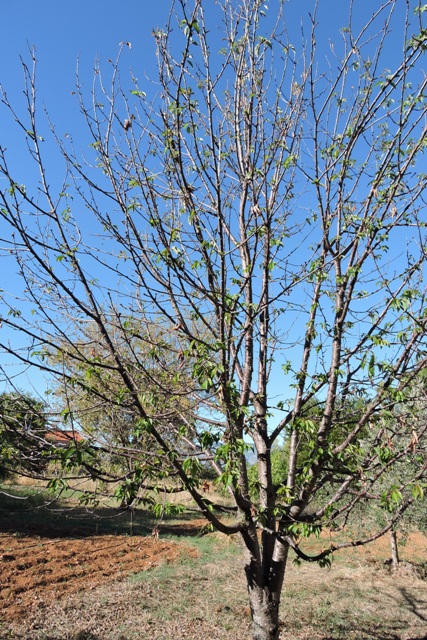
This is of course completely wrong and is yet more evidence, if any at all was needed, of climate breakdown.

There is even some flower blossom showing this week.

The rain we had last week and the cooler temperatures have obviously fooled it into thinking it is spring.
Very soon as the cooler nights arrive, the leaves will die back and fall for a second time this year. However I’m pleased that the earlier leaf fall was the tree’s protection mechanism because of the heat and drought caused by climate breakdown and that it has not died.
Autumn foliage drop isn’t due to the prevailing weather conditions at the time, although this is a common misconception.
Leaves change colour because of the reducing amount of daylight and consequential reduction in photosynthesis. This is called Abscission and is explained very well in this Wikipedia article.
Some gulley’s wanted
This week I have moved all the debris that the builders left outside my yard. I have laid it on top of the stones on the path round the workshop.

This will form a substantial foundation for the eventual “all weather” pavers.
I haven’t been able to finish the work though because I need three square gullys to link to my rainwater recovery system.

They are not available “off the shelf” here. This is because rain water isn’t recovered and guttering and fall pipes just empty onto concrete. So there is no need to have any ‘highfaluting contraption’ to direct water away properly.
In fact many older houses do not even have roof guttering.
I found what I wanted on line, at a cost of £10.99 each. However the company wanted £34.50 each to send them out from the UK. So it is back to the drawing board on this one.
I have been hindered in my search locally and in Europe because I do not know what the correct name for them is.
Volat are going to try and find something in their catalogues for me, but I don’t hold out a great deal of hope!
This week I also began to remove the remaining sand, left over from the Konoba wall’s mortar.
I have filled four plastic sacks and safely stored them. This is so if I need to later match the mortar in the walls I can.
The remaining sand, all ten wheelbarrow loads, I moved down to the orchard. I will use it as the final layer on the path I am building, before I put down more white pebbles.

The space outside will not remain bare for long. I’m about to start removing the spoil from the cottage, now I have somewhere to put it.
So all in all, it has been a busy week again, but with progress to show for my efforts.
Inside clean-up
I started the week by raking the new path around the workshop into something reasonably flat.
There were two small, self sown Passiflora which I carefully dug out and carefully transplanted into plant pots first.
In the past I have really struggled to get any Passion Flowers to grow where I lived. However in Dol, the variety I have in the garden seem to like the poor alkaline soil, positively thriving and climbing anywhere and everywhere they can.
So when I see small self seeded plants, I try and save them, so I can put them where I want them to grow!
With the path now something approaching level, I wanted to make use of the debris that was left by the builders in the Konoba.

As the sun inexorably moved across the sky, I could see another problem which will need to be fixed PDQ. There are some large gaps around the Konoba doors.
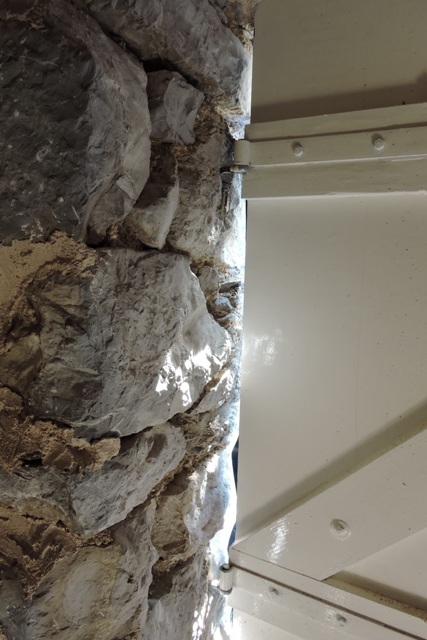
I haven’t even ordered the double glazed doors yet (I’m waiting for the man from Dubrovnik to call), so I re-hung my hand made wooden doors as a stop gap.
When I built the doors I made some wooden profiles for the uneven stonework round the edges. Then I filled in any remaining gap with expanding foam.

All this foam has all been cleaned off when the walls were sandblasted, so the gaps are back.
They have been enlarged in places too, as parts of the broken stonework was removed in the process.
As autumn arrives, so rodents will be looking for somewhere to over-winter, which is definately something I do not want.
I am going to have to fill in the gaps again with some foam. However this time, I will use a low impact adhesive on the stones, to attach kitchen cling film, before I fill any gap.
This is my one-off engineering solution. There is nothing written anywhere about how to attach foam without it sticking to the stone wall. Having just paid for the stones to be cleaned, I don’t want to immediately stick something to them!
I did a test with some hot glue on the stone wall to attach the clingfilm, followed by clingfilm on the painted doors and foam injected between.
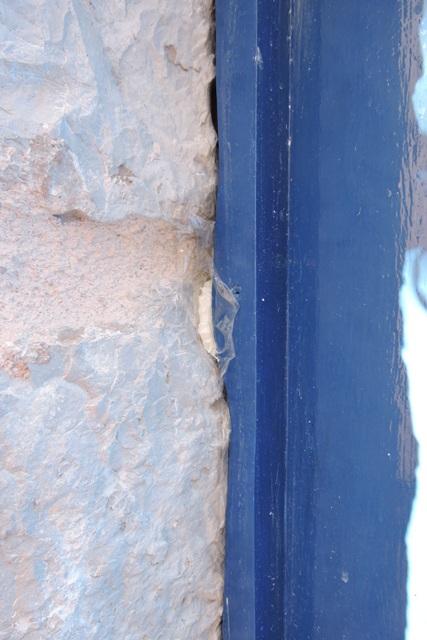
After leaving everything for 24 hours to dry, the hot glue is holding the foam on the clingfilm in place. When I removed the test piece, everything comes away without leaving a mark.

I’ll be happy to go ahead next week and do the complete job.
Halfway house
As the Fava beans continue to grow, I decided to put them outside to begin to acclimatise them. This is so they are away from the steady warmth of the greenhouse and into the natural world outside.
I have a small cold frame on the terrace. This receives afternoon sun, so is warmed and with a fine and sunny day on Monday, I moved the tray out after breakfast.

I’ve prepared a bed in the Top Orchard to take the plants, once they are ready for planting out.
The tray of beans has been brought in at night, but it is at the point now where I am leaving it out 24/7, ready for planting out.
Just two of the bean have not produced any leaves, so I am more than happy with the germination rate.
A tacky surface
I was writing this week in the October PMCC Magazine about restoring a 170 year old Ambrotype photograph.
In the article I made the observation that before you start to clean old photographs, make sure that you try cleaning a small, hidden or unimportant area first.
The same applied to newly cleaned stone walls. The range of adhesives available on the island is limited, so I did some experimentation, in an area which will not be noticeable.
First, I used my hot glue gun and put two blobs of glue, one on a piece of stone and the other on some of the new mortar pointing.
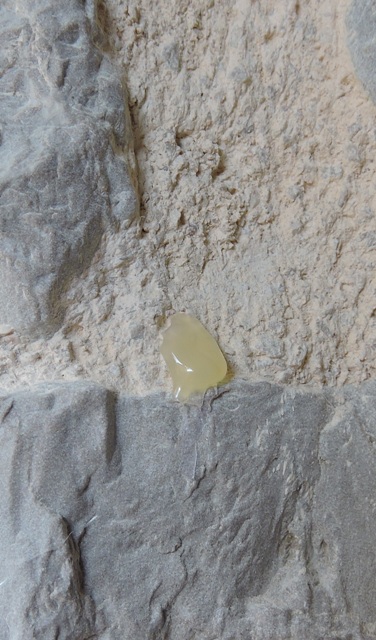
I waited for 24 hours to see how easy they were to remove.
While I had the gun out, I added two more blobs only this time I overlaid them with kitchen transparent cling film.
Then spraying the door with water, I added a second layer of film to the door and between the two I gently squirted some foam into the sandwich.

I was hoping that the blobs of glue from the hot glue gun would be tacky enough to stick to the stone and mortar, but no so tacky that once dry, they will not be easily removable.
I already know that the cling film adheres to a moist surface, like the painted doors.
The thing which I did not know is whether and to what extent the expanded foam will adhere to the plastic film.
I left everything for a 24 hours to properly set. It all worked perfectly!
If the trial fixing had gone badly wrong, then there was just a small area which I would have had to clean up and it will not have been be noticeable to the casual visitor.
Doors closing…
Along with most of northern and Eastern Europe we have seen a temperature drop here in Dol this week.
My windows have been open continuously since the heatwave of early June, and the doors have only been closed when I’ve been shopping.
However with a cold wind from the north east, I’ve been closing the doors and windows to keep the warmth inside overnight.
We are three weeks into the month now and it was time to download the weather data.
Although Meteorologically speaking, the northern Autumn is said to begin at the September Equinox, practically here the first changes are visible in late August.
Three weeks into our extended autumn, we are almost exactly on the average temperature.

Looking at the first nine months of the year, the spring was cooler than the average. The summer has been much hotter than the average.

However what is really concerning is the lack of rainfall, both for the year so far and for the summer.

Mediterranean summer’s are usually hot and dry, but with mild wet winters.
The 2020/2021 winter was quite dry. As at this week in the year, we have a deficit of 500 litres per square metre, over the rainfall average.
Our summers are around sixteen weeks long, lasting from mid May until early September. This year we have received less than half the average summer rainfall.
With the land still parched, I am irrigating my plants and trees, hoping that they will survive. This is until our winter rains should being to arrive next month
A beneficent weed, or is it?
Sometimes I am surprised by the speed at which things grow. One day there is nothing and the next day a profusion of leaves and / or flowers has appeared.
This week my eye was drawn to a large clump of blue flowers, sprouting from the wall next to the donkey track.

They weren’t there last time I looked, or perhaps the sun wasn’t shining on them so their vibrant profusion of colour was not noticeable.
Which ever is the case, their vivid blue colour means that one cannot fail but to notice them at the moment.
In fact, the more you look, the more you see. These weeds are all over the place, growing from cracks between stones, by the side of the tracks and paths.
My neighbour Steve identified the plant as the Common Leadwort, Plumbago europaea.
On the book shelf above my computer I have a copy of the Collins Complete Guide to Mediterranean Wildlife. ISBN 978-0-00220161-2.
Although it is a very good source, it is not quite as “complete” as the title suggests, which was why I couldn’t find the Leadwort. Perhaps the title should be “Common Mediterranean Wildlife”.
I had to go through another three of my wild flower plant books to look this wild flower up. In fact is only appears in one of the Mediterranean Wild Flower books that I have.
I had half recognised the flowers because of their shape, but couldn’t immediately put the name Plumbago to them. The stand of colour reminded me of Ceanothus growing wild but they have different flowers and leaves.
My further online reading suggested that because of the vibrant blue colours, they might in fact have been Plumbago auricultata. Various websites say the Common Leadwort has pink to mauve flowers and these are a very definite blue.

When I looked closely at example petals, the Common Leadwort flower has rounded petals and Auricultata has pointed petals.
Doing some more research into the plant, I discovered a scientific paper published in the Journal of Biological Research, following field research on the Island of Olib, near Zadar.
The Common Leadwort, Plumbago europaea L. flowers on stone walls into October and early November.
The plant exposes its sticky calyx and seed capsules for at least 30 days after flowering. These are then picked up by passing animals and birds.
My felines are forever coming in with burs in their fur.
A large number of small birds overwinter on the Adriatic islands, where the winter weather is milder than the continental European mainland.
The university researchers were looking at migratory Goldcrests on the Island of Olib in the northern Adriatic. These diminutive birds forage for food in amongst low growing plants.
The Leadwort’s adaptive mechanism for spreading seeds, by having the sticky seed capsules, represents a threat to small birds because the capsules easily attach and stick to feathers.
The resulting entangled feathers restrain the birds in their free movement This can cause them to either die or become easy prey for cats, rats or birds of prey.
The researchers estimated from their field observations that at least 47 Goldcrests could have been killed by this natural trap in the built up area of the island of Olib (just 0.388 km²) during one month.
With my large bush up by the wall, I think I will cut it down after flowering, so that any visiting foragers, not to mention my felines, don’t get seeds stuck in their feathers or fur.
Just for fun
For years, since my days at senior school, I have studied the weather.
To gain my pilots licences, I have had to pass a number of Meteorological examinations and I have had my own weather station at home since around 1985.
During this time, I’ve accepted what is generally assumed to be correct, for example the two annual solstice are on December 21st and June 21st, and the two equinox are on March 21st and September 21st. Only they are not!
Leap days get in the way and there is a variation of one or two days either way, for any of the dates, in any given year.
This week Wednesday 22nd September was the northern autumnal equinox. The word comes like so many things in science, from the Latin and means equal day and night.
A couple of years ago I came across a reference in a science paper to the fact that on the Equinox, day and night is not precisely equal. This is because of the way sunrise and sunset are calculated.
With a clear, defined horizon, which I had in Abu Dhabi but is missing in Dol because of the surrounding hills, the moment of sunrise is defined as the second the upper edge of the sun’s disc appears above the horizon.
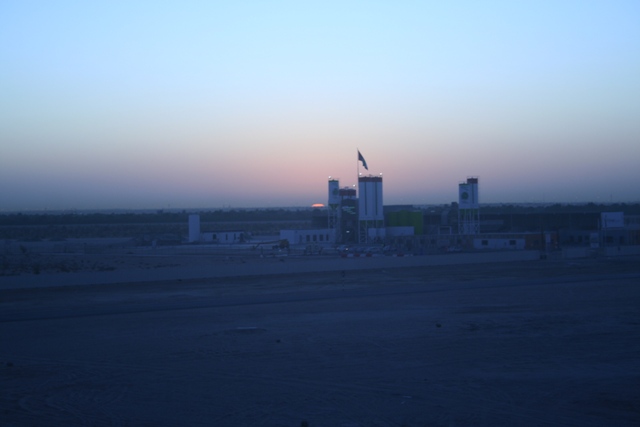
The moment of sunset is when the upper edge of the sun disapears from view. Day length is the time between the two events.
Now here is the conundrum. Light is refracted (bent) through the atmosphere on its way to the earth’s surface. This causes the sun to appear higher in the sky than it really is both at sunrise and sunset.
Sunrise apparently occurs before the Sun actually reaches the horizon because the sunlight is refracted by the Earth’s atmosphere.
At the horizon, the average amount of refraction is 34 arcminutes, or one solar disc circumference, although this amount can vary based on atmospheric conditions.
So when we see the sun’s disc appear above a flat horizon, it is actually still one disc diameter below. We are looking at a refracted image.
The reverse happens at sunset. The sun is already completely below the horizon when an observer sees the tip of the disc disappear.
On the equinox, the centre of the Sun is indeed above the horizon for 12 hours.
However, “sunrise” is said to begin when the upper edge of the Sun’s disk becomes visible above the horizon and ends when the entire Sun has set.
This week daylight is still a little bit longer than night time, but only by twelve minutes.
Tomorrow, Sunday the 26th September is the actual date when there is exactly 12 hours of day and 12 hours of night.
Giving some latitude
Throughout this year I have been keeping a record of my sunrise and sunset times, based on my Latitude and Longitude.
The closer you are to the equator, the less variation there is in day length.
Latitude (the distance from the equator) only affects the day’s length, whereas longitude (east or west of the Ø meridian) affects the time your days and nights start.
On the winter and summer solstice, there is no change to the daylight and darkness hours. They are neither increasing nor reducing by seconds and minutes.
After the 22nd September, this daily change starts to reduce until 22nd December.
From the winter solstice, by just a few seconds a day to start with, the daylight hours begin to lengthen until 20th March 2022, the next equinox.
The closer you are to the poles, the greater the difference, where above the Arctic Circle in summer there is 24 hours of sunlight and in mid winter, no sunlight at all.
So because daylength is not measured from the centre of the suns disc crossing the horizon, it means that on this Autumnal Solstice, the day length is actually 12 hours and 12 minutes.
The most northerly weather station close to the 16 degrees east meridian is Svaldrone on the island of Svaldbard, Sweden. The length of the day is the same along each lonitude meridian.

However in Svalbard daylight is reducing by 15 minutes every day at the moment, a very noticeable amount.
The most southerly European station on the same meridian is Soverato, on the instep of Italy’s ‘boot’.
Here the day length is reducing by just two minutes. Of course on the Equator, with the sun directly overhead, day length is neither reducing nor increasing.
Here in Dol, it is actually the 26th September when there is precisely 12 hours of daylight, so the 21st of September is not so far out… NCG
Looking back – Week 38
This is the start of the links to past issues of the blog from this week in previous years.
2014/38 Three down and one to go!
2015/38 Adapting the plan for the circumstances

2016/38 No job is ever quite as easy as it seemst

2017/38 We’re OK, the milk is Halal!!
2018/38 Watching the Mongoose

2019/38 Visiting the shrink

2020/38 Make do and mend
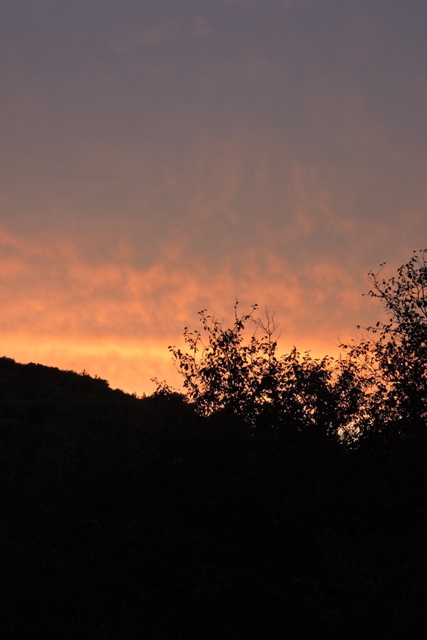
2 Responses
Marcy Fletchall
Norman, I totally loved the pictures and explanation. Lovely. I hope you are well and have a lovely week. Marcy
STEPHEN PAUL HORSLEY
Norman,
Think you need a ‘Square Hopper’ or ‘Rectangular Hopper’ or possibly, depending on your system, a ‘Square Back-Inlet Hopper’ etc. See MKM Building Supplies site for more. Prices rising here VERY fast.
Paul